#Chicken Musakhan
Explore tagged Tumblr posts
Text

Traditional Palestinian Musakhan
#food#recipe#dinner#musakhan#chicken#onions#pine nuts#sumac#chick pea#garlic#naan#flatbread#palestinian#dairy free#baking
57 notes
·
View notes
Text
I made Palestinian food and it fucking slaps why have I gone this long without ever making it before
6 notes
·
View notes
Text
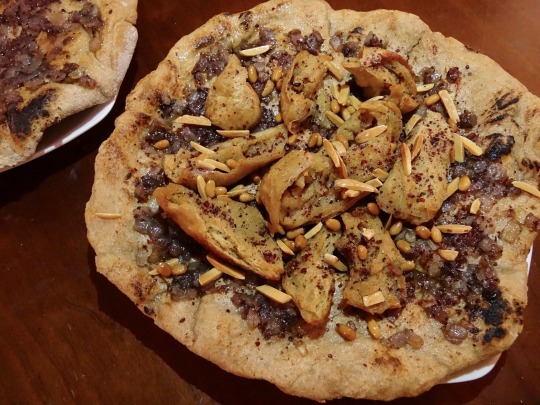

[ID: Two large flatbreads. The one in the center is topped with bright purple onions, faux chicken, fried nuts, and coarse red sumac; the one at the side is topped with onions and sumac. Second image is a close-up. End ID]
مسخن / Musakhkhan (Palestinian flatbread with onions and sumac)
Musakhkhan (مُسَخَّن; also "musakhan" or "moussakhan") is a dish historically made by Palestinian farmers during the olive harvest season of October and November: naturally leavened flatbread is cooked in clay ovens, dipped in plenty of freshly pressed olive oil, and then covered with oily, richly caramelized onions fragrant with sumac. Modern versions of the dish add spiced, boiled and baked chicken along with toasted or fried pine nuts and almonds. It is eaten with the hands, and sometimes served alongside a soup made from the stock produced by boiling the chicken. The name of the dish literally means "heated," from سَخَّنَ "sakhkhana" "to heat" + the participle prefix مُـ "mu".
I have provided instructions for including 'chicken,' but I don't think the dish suffers from its lack: the rich, slightly sour fermented wheat bread, the deep sweetness of the caramelised onions, and the true, clean, bright expressions of olive oil and sumac make this dish a must-try even in its original, plainer form.
Musakhkhan is often considered to be the national dish of Palestine. Like foods such as za'tar, hummus, tahina, and frika, it is significant for its historical and emotional associations, and for the way it links people, place, identity, and memory; it is also understood to be symbolic of a deeply rooted connection to the land, and thus of liberation struggle. The dish is liberally covered with the fruit of Palestinian lands in the form of onions, olive oil, and sumac (the dried and ground berries of a wild-growing bush).
The symbolic resonance of olive oil may be imputed to its history in the area. In historical Palestine (before the British Mandate period), agriculture and income from agricultural exports made up the bulk of the economy. Under مُشَاعْ (mushā', "common"; also transliterated "musha'a") systems of land tenure, communally owned plots of land were divided into parcels which were rotated between members of large kinship groups (rather than one parcel belonging to a private owner and their descendants into perpetuity). Olive trees were grown over much of the land, including on terraced hills, and their oil was used for culinary purposes and to make soap; excess was exported. In the early 1920s, Palestinian farmers produced 5,000 tons of olive oil a year, making an average of 342,000 PL (Palestinian pounds, equivalent to pounds sterling) from exports to Egypt alone.
During the British Mandate period (from 1917 to 1948, when Britain was given the administration of Palestine by the League of Nations after World War 1), acres of densely populated and cultivated land were expropriated from Palestinians through legal strongarming of and direct violence against, including killing of, فَلّاَحين (fallahin, peasants; singular "فَلَّاح" "fallah") by British troops. This continued a campaign of dispossession that had begun in the late 19th century.
By 1941, an estimated 119,000 peasants had been dispossessed of land (30% of all Palestinian families involved in agriculture); many of them had moved to other areas, while those who stayed were largely destitute. The agriculturally rich Nablus area (north of Jerusalem), for example, was largely empty by 1934: Haaretz reported that it was "no longer the town of gold [i.e., oranges], neither is it the town of trade [i.e., olive oil]. Nablus rather has become the town of empty houses, of darkness and of misery". Farmers led rebellions against this expropriation in 1929, 1933, and 1936-9, which were brutually repressed by the British military.
Despite the number of farmers who had been displaced from their land by European Jewish private owners and cooperatives (which owned 24.5% of all cultivated land in Palestine by 1941), the amount of olives produced by Palestinians increased from 34,000 tons in 1931 to 78,300 in 1945, evidencing an investment in and expansion of agriculture by indigenous inhabitants. Thus it does not seem likely that vast swathes of land were "waste land," or that the musha' system did not allow for "development"!
Imprecations against the musha' system were nevertheless used as justification to force Palestinians from their land. After various Zionist organizations and militant groups succeeded in pushing Britain out of Palestine in 1948—clearing the way for hundreds of thousands of Palestinians to be dispossessed or killed during the Nakba—the Israeli parliament began constructing a framework to render their expropriation of land legal; the Cultivation of Waste Lands Law of 1949, for example, allowed the requisition of uncultivated land, while the Absentees’ Property Law of 1950 allowed the state to requisition the land of people it had forced from their homes.
Israel profited from its dispossession of millions of dunums of land; 40,000 dunums of vineyards, 100,000 dunums of citrus groves, and 95% of the olive groves in the new state were stolen from Palestinians during this period, and the agricultural subsidies bolstered by these properties were used to lure new settlers in with promises of large incomes.
It also profited from the resulting "de-development" of the Palestinian economy, of which the decline in trade of olive oil furnishes a striking example. Palestinian olive farmers were unable to compete with the cheaper oils (olive and other types) with which Zionist, capital-driven industry flooded the market; by 1936, the 342,000 PL in olive oil exports of the early 1920s had fallen to 52,091 PL, and thereafter to nothing. While selling to a Palestinian captive market, Israel was also exporting the fruits of confiscated Palestinian land to Europe and elsewhere; in 1949, olives produced on stolen land were Israel's third-largest export. As of 2014, 12.9% of the olives exported to Europe were grown in the occupied West Bank alone.
This process of de-development and profiteering accelerated after Israel's military seizure of the West Bank and Gaza in 1967. In 1970, agriculture made up 34% of the GDP of the West Bank, and 31% of that of Gaza; in 2000, it was 16% and 18%, respectively. Many of those out of work due to expropriated or newly unworkable land were hired as day laborers on Israeli farms.
Meanwhile, Palestinians (and Israeli Palestinians) continued to plant and cultivate olives. The fact that Palestinians do not control their own water supplies or borders and may expect at any time to be barred by the military from harvesting their fields has discouraged investment and led to risk aversion (especially since the outmoding of the musha' system, which had minimized individual risk). In this environment, olive trees are attractive because they are low-input. They can subsist on rainwater (Israel monopolizes and poisons much of the region's water, and heavily taxes imports of materials that could be used to build irrigation systems), and don't require high-quality soil or daily weeding. Olive trees, unlike factories and agricultural technology, don't need large inputs of capital that stand to be wasted if the Israeli military destroys them.
Olive trees are therefore the chosen crop when proving a continued use of land in order to prevent the Israeli military from expropriating it under various "waste" or "absentee" land laws. Palestinians immediately plant olive seedlings on land they have been temporarily forced from, since even land that has lain fallow due to status as a military closed zone can be appropriated with this justification. The danger is so pressing that Palestinian agronomists encouraged this habit (as of 1993), despite the fact that Israeli competition and continual planting had lowered olive crop prices, and despite the decline in soil quality that results from never allowing land to lie fallow. In more recent years, olive trees have yielded primary or supplementary income for about 100,000 Palestinian families, producing up to 191 million USD in value in good years (including an average of 17,000 tons of olive oil yearly between 2001 and 2009).
Israeli soldiers and settlers have famously uprooted, vandalized, razed, and burned millions of these olive trees, as well as using military outposts to deny Palestinian farmers access to their olive crops. It prefers to restrict Palestinians to annual crops, such as vegetables and grains, and eliminate competition in permanent crops, such as fruit trees.
This targeting of olive trees increases during times of intensified conflict. During the currently ongoing olive harvest season (November 2023), Gazan olive farmers have reported being targeted by Israeli war planes; some farmers in the West Bank have given up on harvesting their trees altogether, due to threats issued by organized networks of settlers that they would kill anyone seen making the attempt.
The rootedness of olive trees in the history of Palestine gives them weight as a symbol of homeland, culture, and the fight for liberation. Palestinian olive harvest festivals, typically celebrated in October with singing, dancing, and eating, have inspired similar events elsewhere in the world, aimed at sharing Palestinian food and culture and expressing solidarity with those living under occupation.
Support Palestinian resistance by calling Elbit System’s (Israel’s primary weapons manufacturer) landlord, donating to Palestine Action’s bail fund, and donating to the Bay Area Anti-Repression Committee bail fund.
Ingredients:
For the dish:
2 pieces taboon bread, preferably freshly baked
2 large or 3 medium yellow onions (480g)
1 cup first cold press extra virgin olive oil (زيت زيتون البكر الممتاز)
1 Tbsp coarsely ground Levantine sumac (سماق شامي / sumaq shami), plus more to top
Ground black pepper
For the chicken (optional):
500g chicken substitute
5 green cardamom pods, or 1/4 tsp ground cardamom
4 cloves, or pinch ground cloves
1 Mediterranean bay leaf
1 Tbsp ground sumac
For the nut topping (optional):
2 Tbsp slivered almonds
2 Tbsp pine nuts
Neutral oil, for frying
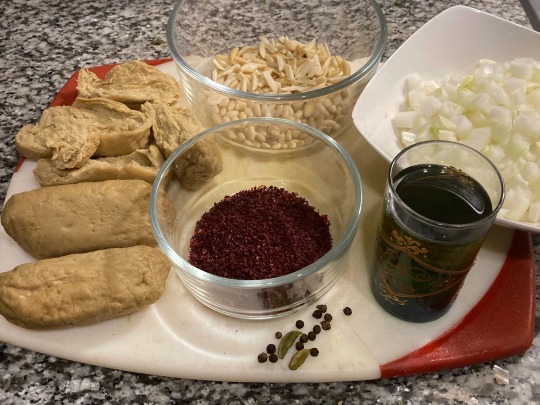
Notes on ingredients:
Use the best olive oil that you can. You will want oil that has some opacity to it or some deposits in it. I used Aleppo brand olive oil (7 USD a liter at my local halal grocery).
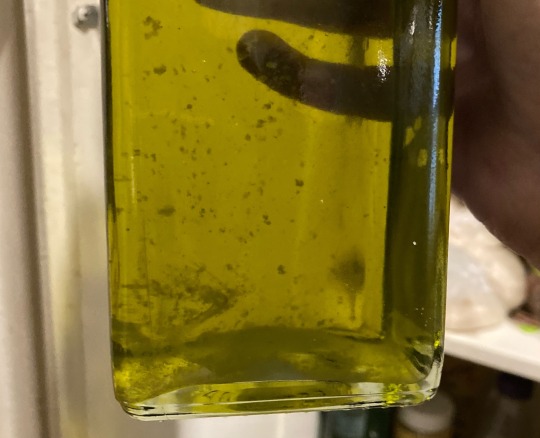
If you want to replace the taboon bread with something less laborious, I would recommend something that mimics the rich, fermented flavor of the traditional, whole-wheat, naturally leavened bread. Many people today make taboon bread with white flour and commercial yeast—which you might mimic by using storebought naan or lavash, for example—but I think the slight sourness of the flatbread is a beautiful counterpoint to the brightness of the sumac and the sweetness of the caramelized onions. I would go with a sourdough pizza crust or something similar.
Your sumac should be coarsely ground, not finely powdered; and a deep, rich red, not pinkish in color (like the pile on the right, not the one on the left).

For this dish, a whole chicken is usually first boiled (perhaps with spices including bay leaves, cardamom, and cloves) and then baked, sometimes along with some of the oil from frying the onions. I call for just frying or baking instead; in my opinion, boiling often has a negative effect on the texture of meat substitutes.
Instructions:
For the onions:
1. Heat a cup of olive oil in a large skillet or pot. Fry onions on medium-low, stirring often, for 10 minutes or until translucent.

2. Add 1 Tbsp sumac and a few cracks of black pepper and reduce to low. Cook for another 30 minutes, stirring occasionally, until onions are sweet, reduced in volume, and pinkish in color.
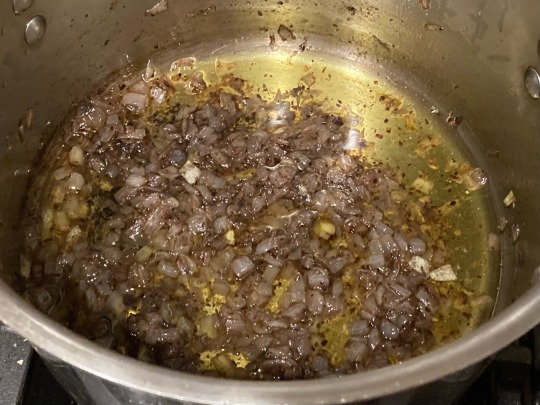
For the chicken:
1. Briefly toast and finely grind spices except for sumac (cardamom, cloves, and bay leaf). Filter with a fine mesh sieve. Dip 'chicken' into the pot in which you fried the onions to coat it with olive oil, then rub spices (including sumac) onto the surface.
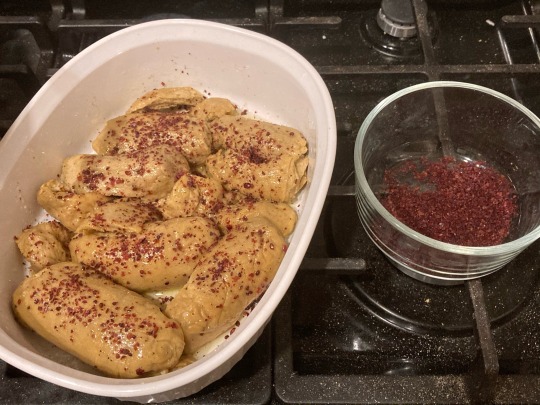
2. Sear chicken in a dry skillet until browned on all sides; or bake, uncovered, in the top third of an oven heated to 400 °F (200 °C) until browned.
For the nut topping:
1. Heat a neutral oil on medium in a small pot or skillet. Add almonds and fry for 2 minutes, until just starting to take on color. Add pine nuts and fry until both almonds and pine nuts are golden brown. Remove with a slotted spoon.
To assemble:
1. Dip each flatbread in the olive oil used to fry the onions, then spread onions over the surface.
Some cooks dip the bread entirely into oil; others press it lightly into the surface of the oil in the pot on both sides, or one side; a more modern method calls for mixing the olive oil with chicken broth to lighten it. Consult your taste. I think the bread from my taboon recipe stands up well to being pressed into the oil on both sides without tearing or becoming soggy.
2. Top flatbread with chicken and several large pinches more sumac. Bake briefly in the oven (still heated to 400 °F / 200 °C), or broil on low, for 3-5 minutes, until the sumac and the surface of the bread have darkened a shade.
3. Top with fried nuts.
Musakhkhan is usually eaten by ripping the chicken into bite-sized pieces, tearing off a bit of bread, and eating the chicken using the bread.
Some cooks make a layered musakhkhan, adding two to three pieces of bread covered with onions on top of each other before topping the entire construction with chicken and pine nuts.
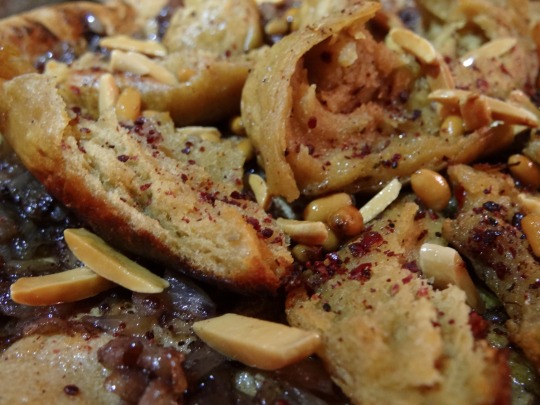
728 notes
·
View notes
Text
Fun Fact
Musakhan (also known as muhammar) is often considered to be the national dish of Palestine! It looks really yummy and is usually served with soup.

One big old chicken leg on taboon bread with some onions, roasted pine nuts, and spices! I'm not sure how exactly to eat this, but I'd definitely give it a try.
Source: Wikipedia
26 notes
·
View notes
Note
hii
26. how’s your spice tolerance?
28. last meal on earth?
26. okay, so since i’m half Iranian and most of my childhood i grew up eating only iranian food i have a very high spice tolerance ++ cuz most of my friends were east or south asian n i always had really spicy food with them
28. my last meal on earth would 100% be fresh m’semen with almond butter, argan oil and spurge honey + musakhan (which is roasted chicken that is baked with onions, spices and fried pines nuts, then served on taboon bread) and finally a good corner to al pistacchio that falls apart in my mouth
honourable mentions: japchae with a side of kimchi + katsu sando + omurice + JOLLOF RICE 🫶🫶 + congee with chilly oil (idk if this is customary but that’s how i’ve always eaten it) + baozi + empanadas (any really) + argentine meat (i’m literally vegetarian but it has always tempted me) + PHO
#ugh i love food so much#msamen is a moroccan flatbread made w semolina n flour and it’s the most perfect thing ever#its basically folded over 1000 times with butter on every layer#its so fucking good#i make it like once a week or i die#also palestinian food is so fucking good#i had musakhan once#and it changed my whole existence#i would have a whole buffet with every food ever made n eat a bit of everything#i love food
3 notes
·
View notes
Text
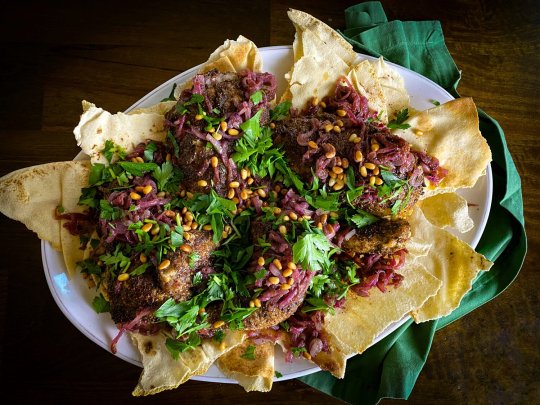
Musakhan
sumac, cumin, allspice, cinnamon, cardamom
2 chicken legs, with skin and bone, or skin-on breast or ½ chicken
salt and pepper
3 medium red and or white onions, finely chopped
2 Tbsp sumac
2–4 pita bread, wheat tortillas or similar
2 Tbsp pine nuts or almonds
1 small handfull flat-leaf parsley, or coriander
Mix the spices to coat the chicken, then fry on a high heat. In the meantime, make an onion confit by slow frying the onions, season with salt, pepper and sumac. Serve with roasted nuts, fresh parsley, coriander
0 notes
Text
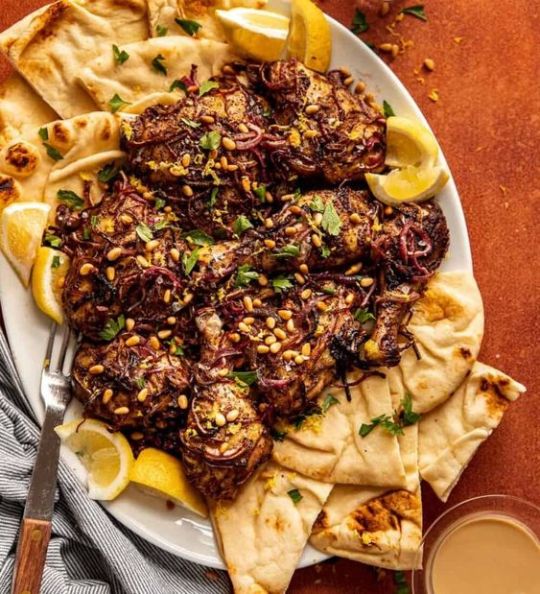
Musakhan (Sumac Chicken)
Serving: 4
Ingredients
4 cloves garlic, minced
3 tablespoons olive oil
2 tablespoons sumac
1 tablespoon kosher salt
2 teaspoons ground cumin
1 ½ teaspoons allspice
1 ½ teaspoons ground coriander
3 –3 ½ pounds bone-in, skin-on chicken thighs and drumsticks
1 large red onion, quartered and very thinly sliced (mandolin)
¼ cup pine nuts
4 –6 naan, pita, or Taboon bread, warmed, for serving
Tahini, lemon and parsley for serving
Directions
In a large bowl combine 4 minced cloves garlic, 3 tablespoons olive oil, 2 tablespoons sumac, 1 tablespoon salt, 2 teaspoons cumin, 1½ teaspoons allspice, and 1½ teaspoons coriander. Mix into a paste.
Trim excess skin from 3 pound bone-in, skin on chicken thighs and drumsticks.
Using a knife, slash each piece of chicken all over (4 or 5 times); add chicken pieces and 1 very thinly sliced red onion to spice mixture. Toss to coat chicken with spices, working some of spice mixture and onion slices under skin of chicken. Cover and chill for 1–4 hours.
When ready to cook, preheat oven to 375ºF with racks set in upper and middle position. Arrange ¼ cup pine nuts on a small baking sheet; toast in oven until golden brown and fragrant, 6–8 minutes. Set pine nuts aside. Increase oven to 425ºF.
Arrange chicken in an even layer on a quarter sheet pan; sprinkle onions over top. Roast chicken on middle rack until juices run clear and an instant-read thermometer inserted in the thickest areas, but not touching the bone, registers 172ºF, about 30 minutes.
Turn oven to broil and move chicken to upper rack, broil until skin is browned, onions start to char, and an instant-read thermometer inserted in the thickest areas, but not touching the bone, registers between 175ºF and 180ºF, 5–15 minutes more (all broilers are different—keep an eye on your chicken! This could take just 5 minutes for you while other oven can take up to 15 minutes).
Remove chicken from oven and let rest. Turn oven off and place breads directly on middle rack—heat just to warm through, about 4 minutes.
Transfer breads to a platter, nestle chicken and onions alongside bread; drizzle with some of the chicken juices. Sprinkle pine nuts and parsley over top. Serve with lemon wedges and thinned tahini (see notes).
Notes
Thinned tahini: This is simple tahini + water + kosher salt. Tahini will seize up when water is first added. Start with a ¼ cup of tahini and add a tablespoon or two of water. Whisk to combine then keep adding water, by tablespoon, until it’s drizzly, light in color and luscious. Season to taste with salt.
Eating instructions: Yes I’m giving you eating instructions! Cut off a piece of chicken and pile it onto a small piece of naan with a schmear of thinned tahini, some parsley and a squeeze of lemon. This is GOOD!
Chicken juices: After roasting, there will be a lovely pool of seasoned chicken juices. They are delicious. Drizzle some of that over the chicken then reserve the rest for something else. This is essentially reduced chicken dripping that will make a great base for soups, stews and sauces.
(Source)
0 notes
Text
10 Interesting Facts About Palestine
Discover 10 interesting facts about Palestine, known for its historic religious sites, ancient cities, rich cultural heritage, and political significance.
Basic Information About Palestine Country Full Name: State of Palestine Continent: Asia Official Language: Arabic Currency: Israeli Shekel (ILS), Jordanian Dinar (JOD), and Egyptian Pound (EGP) Capital: East Jerusalem (proclaimed), Ramallah (administrative) Main Dish: Musakhan (sumac-seasoned chicken with onions and bread) Famous For: Historic religious sites, ancient cities, rich cultural…

View On WordPress
0 notes
Photo
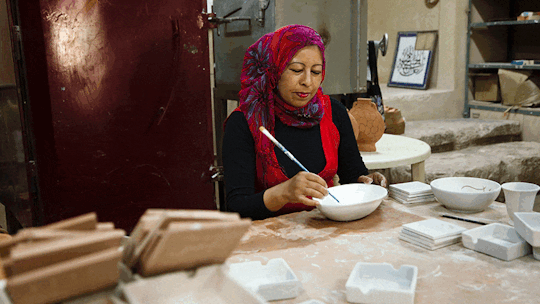
At the Iraq Al-Amir Women’s Co-Operative, a packed lunch spot on the outskirts of Amman, a clowder of cats chase each other across the small outdoor patio while tourists enjoy large portions of traditional Jordanian food such as musakhan (spiced chicken) and magloubet zahra (chicken, rice and cauliflower). But this is so much more than a popular eatery. Established in 1993 by Noor Al Hussein Foundation, Iraq Al-Amir is Jordan’s oldest women’s co-operative and since going fully independent in 2001 it has trained over 150 women who have since gone on to establish businesses – including food establishments – of their own. But as Yusra Al Husami, the president of the co-operative, explains, while it has been rewarding, it hasn’t been easy.
(via The Jordanian Co-Operative Raising Up Female Entrepreneurs | Service95)
#service95#service 95#dua lipa#travel#jordan#Iraq Al-Amir Women’s Co-Operative#activism#middle east#lunch
1 note
·
View note
Text
The World's Most Famous Foods
I would say Ramen if you asked me. I've tried wide different varieties because I adore them. One of my favorite foods; you should try it if you haven't already. There are so many variations of Ramen that it is impossible to list them all.
If you're unfamiliar, dim sum is a Chinese food that translates to "touch the heart." This particular savory snack is frequently provided with tea. Numerous varieties of dumplings, noodle rolls, and other foods are available.
You can eat dim sum, either steamed or fried. With each dish, a different filling is used. For instance, the har gow, a traditional Cantonese dim sum, comprises chopped shrimp wrapped in thin skin. Soy sauce is usually served with this. The siu mai, a pork and shrimp dumpling is another well-liked dim sum dish. Among the fillings in this dish are ground pork, green onions, and mushrooms.
A kebab is a meat dish typically served on skewers in Turkey. Kebabs come in various varieties and can be eaten with various toppings. The meat is generally stewed with tomato and onion. Different types of vegetables are also used, though.
Popular Turkish street food is doner kebab. It is made of doner meat that has been thinly sliced and cooked on a vertical rotating spit. The heart is then grilled, and various toppings are added. The doner kebab can be consumed as a sandwich or traditionally served on pita bread.
Greek casserole called moussaka is made with meat and eggplant. It is a well-known Turkish and Balkan recipe. Although its origins are unknown, it is most likely from the Middle East or one of the Arabic nations. Moussaka can be made in various ways, but it's most frequently made as a layered baked dish. There are typically three layers.
Typically, eggplant fills the bottom layer of the casserole. A thick bechamel sauce is placed on top of the baked good. Additionally, some variations contain potatoes and zucchini. "moussaka" was initially used to describe a dish made with thinly sliced eggplant. This dish is also known as musakhan, musakhkhan, or makhana.
One of the most consumed foods worldwide is Ramen. This soup's origins date back hundreds of years to China. It was introduced to Japan, where it is now well-known. A variety of noodles and flavored broth are used to make the dish. The soup is topped with various ingredients, such as pork, chashu, bean sprouts, spinach, and soft-boiled eggs.
Despite having its roots in China, Ramen eventually made its way to Japan. Immigrants from the nation brought the dish to Yokohama in the 19th century, where it quickly gained popularity. The Taisho era (1912–1926) saw an increase in ramen shops opening. Many people discovered Ramen was a filling meal after the war, especially for urban workers and soldiers. It evolved into a simple, affordable method of consuming food.
A dish made of grains called Couscous has its roots in North Africa. It is now a well-liked food on a global scale. For many types of cuisine, it is a necessary side dish. Typically, vegetables or meat are served with Couscous in North African and Middle Eastern cuisine. The versatile food couscous is also simple to make. It can serve as the foundation for other dishes or as a salad. On the other hand, Couscous is typically done with a sauce, like buttermilk or orange flower water.
This straightforward dish is a typical side in Moroccan and Algerian cooking. Couscous is typically made with lamb or chicken in Morocco, but it can also be made with beef, fish, or rabbit. Almonds, cinnamon, sugar, and dates are additional couscous ingredients that can be used.
The green papaya salad is a mouthwatering combination of tastes and textures. Southeast Asia is known for this dish. Papaya is a simple vegetable to locate at an Asian grocer. Garlic, chili, palm sugar, and shredded unripe papaya are among the ingredients in green papaya salad. A food processor, mortar, and pestle can be used to make this salad.
You can use white soy sauce instead of fish sauce to make a vegetarian version of this salad. Additionally, you can omit the dried shrimp. Depending on your preferences, you can also add extras like bell peppers, fried onions, and almonds.
0 notes
Text

Chicken Musakhan
#food#recipe#dinner#musakhan#chicken#onions#flatbread#sumac#almond#pine nuts#lemon#cinnamon#palestinian
50 notes
·
View notes
Text
Dina's attention was caught by the question after getting lost in her father's life story of tragedy and she nodded trying to come up with a well worded answer. cuts up the chicken in her musakhan
"I really just want the normalcy I was denied" dina admitted after she finished chewing, the question was one she didn't expect so she just came up with an honest answer on the spot. "I finally have the freedom and relationships that make me want to keep going every day; even though I could loose either at any given time that doesn't make them lest special to me"
"Though I'll admit living at a school that's gets blown up so much you'd wonder why people keep sending their kids there.... doesn't make much sense" she chuckled "but I guess if the classroom blows up in the first 15 minutes of class we get to leave" she started giggling at her own dark joke
"I also want to get better at doing more grand things with my powers cause sinister really held me back, but I am doing pretty good considering i was able to make no one in the restaurant think our conversation is anything but normal" she reveals before manifesting a straw in her drink and taking a sip.
@weebwholovesuchihasasuke Because you Like/Reblogged
Magneto stands at the edge of the training grounds, his imposing figure casting a long shadow. The air hums with a quiet intensity as he watches Dina practice, his expression unreadable. With a deep breath, he steps forward, his cape billowing slightly in the breeze.
"Dina," he calls out, his voice firm yet gentle.
As she turns to face him, he approaches with measured steps, his eyes studying their face closely. "I am Magneto," he begins, his tone carrying the weight of his name. "I've come to speak with you about something of great importance."
He pauses, searching for the right words. "I know this may come as a shock, but I am your father. I have watched you from afar, knowing that one day this moment would come."
Magneto's gaze softens, a rare vulnerability showing through. "I understand if you have questions, or if you feel anger or confusion. But know that I am here now, and I want to be a part of your life, to help you understand your abilities and your heritage."
He extends a hand, a tentative yet hopeful gesture. "Will you allow me the chance to explain, to show you the truth of who we are?"
54 notes
·
View notes
Text
Chicken Musakhan

This deliciously fragrant Chicken Musakhan, Palestine’s national dish, of which I found the recipe in last month’s The Simple Things, is a wonderful Sunday Lunch. It only takes minutes to prepare, then you put it in the oven, and you can do a bit of gardening, working out your appetite, before eating it, with your fingers, in front of the rugby. If that doesn’t ound like a perfect Sunday! Have a good one, mates!
Ingredients (serves 2):
3 chicken thghs (about 400 grams/14.10 ounces)
1 1/2 teaspoon ground sumac
1/2 teaspoon ground cumin
1/2 teaspoon allspice
1/4 teaspoon Red Chili Flakes
1/4 teaspoon ground cinnamon
1/2 teaspoon fleur de sel or sea salt flakes
1/2 teaspoon freshly cracked black pepper
2 tablespoons olive oil
1/2 red onion
3 tablespoons olive oil
1/2 teaspoon ground sumac
1 sprig fresh parsley
2 lemon wedges
Preheat oven to 220°C/430°F.
Put chicken thighs in a baking dish. Sprinkle genreously with sumac, cumin, allspice, Red Chili Flakes , cinnamon, fleur de sel and black pepper. Drizzle with olive oil, and rub thoroughly with clean hands, massaging the spices and oil into the meat.
Place in the middle of the hot oven, and roast, at 220°C/430°F, for 30 to 40 minutes, until the skin is nicely browned and crispy.
A quarter of an hour before the chicken finishes cooking, thinly slice red onion. Heat olive oil in a small frying pan over medium-low heat. Add onion slices, and fry, over a low flame, 10 to 15 minutes. Stir in sumac, cook one minute more.
Serve Chicken Musakhan hot, sprinkled with fried red onion and fresh parsley, with lemon wedges and Greek Yogurt on the side, and warm Rosemary Flatbreads.
#Recipe#Food#Chicken Musakhan#Chicken Musakhan recipe#Chicken and Poultry#Chicken Thighs#Chicken#Sumac#Ground Sumac#Cumin#Ground Cumin#Allspice#Red Chili Flakes#Cinnamon#Ground Cinnamon#Fleur de Sel#Black Pepper#Black Peppercorns#Olive Oil#Red Onion#Parsley#Fresh Parsley#Lemon#Lemon Wedges#Rosemary Flatbreads#Flatbreads#Greek Yogurt#Palestinian Cuisine#Mediterranean and Greek Cuisine#The Simple Things
9 notes
·
View notes
Photo

[OC] Palestinian fried chicken and Musakhan Check this blog!
9 notes
·
View notes
Photo

[homemade] Musakhan sumac roasted chicken over flatbread with homemade hummus and fried halloumi
15 notes
·
View notes
Text
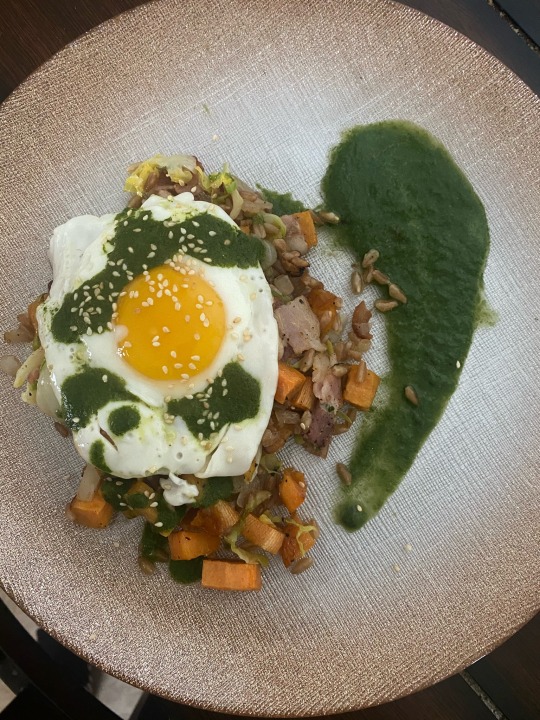








top 9 meals made in march
(top: farro and sweet potato hash with chermoula, roasted salmon skewers with grilled squash and charred eggplant sauce, veggie pizza. middle: chicken musakhan with pita, chicken piccata with broccolini, ham and grits. bottom: zuppa toscana with spinach gnocchi; pho tái; and flatbread, mint lime chutney, paneer with burst cherry tomatoes and snap peas, and aloo tikki.)
62 notes
·
View notes